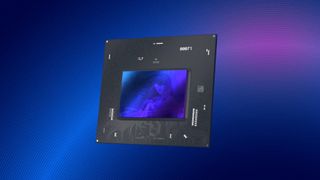Intel Arc GPU fix brings massive increase in performance - from single line of code
Ray tracing should now work properly on Arc cards thanks to an eagle-eyed driver engineer

A single line of code - that’s all it took for a massive increase in ray tracing performance on Intel’s Arc Alchemist GPUs, thanks to Intel graphics driver engineer Lionel Landwerlin. With Intel's new graphics cards floundering somewhat with performance woes and driver teething issues, it’s a welcome sight.
Landwerlin describes the change as "like a 100x (not joking) improvement" in the text description of his merge request for the new line of code. That sounds like hyperbole, but a quick dig through the request’s details makes it immediately clear that it's not.
Don’t worry; we won’t get overly complex with this explanation. Intel’s DG2 "Alchemist" GPU has been in development for years, and Intel has been aiming to implement Vulkan ray tracing capabilities since at least 2020. When this driver was originally written, a minor oversight from the original engineer saw the GPU draw from system memory (the motherboard-mounted RAM) rather than local memory (the GPU’s onboard VRAM).
This resulted in a huge performance drop because the GPU needed to communicate with the system memory to process ray tracing directives, which introduced a level of memory latency that was unacceptable. The fix - a lone line of code that flags the local memory for the allocation of ray tracing processes - means that performance is now at the level it should have been all along.
Analysis: Intel needs every advantage it can get right now
Intel’s heavily-delayed Arc GPU series is finally appearing in the wild, with the budget A3 cards available now in some Asian markets while the more powerful gaming-oriented A7 GPUs are already being teased for a global launch.
Still, Intel should be worried; initial impressions of Arc have been lackluster, and serious competition is on the way in the form of Nvidia’s Lovelace and AMD’s RDNA 3 GPUs. The first-gen Arc cards look like they’ll compete with the current-gen offerings from Team Green and Team Red, but Intel needs to get these cards on sale fast if it wants to secure any significant amount of market share.
This driver fix, combined with signs that Intel might have erred on the side of caution with the power draw of Arc cards resulting in lower initial gaming performance, indicates that Intel could yet remain competitive with the best graphics cards on the market. We still have hope that the Arc series will become a serious competitor to GeForce and Radeon, but only time will tell. But hey, at least crypto miners won’t be scalping them.
Get daily insight, inspiration and deals in your inbox
Get the hottest deals available in your inbox plus news, reviews, opinion, analysis and more from the TechRadar team.
From Phoronix.

Christian is TechRadar’s UK-based Computing Editor. He came to us from Maximum PC magazine, where he fell in love with computer hardware and building PCs. He was a regular fixture amongst our freelance review team before making the jump to TechRadar, and can usually be found drooling over the latest high-end graphics card or gaming laptop before looking at his bank account balance and crying.
Christian is a keen campaigner for LGBTQ+ rights and the owner of a charming rescue dog named Lucy, having adopted her after he beat cancer in 2021. She keeps him fit and healthy through a combination of face-licking and long walks, and only occasionally barks at him to demand treats when he’s trying to work from home.
Most Popular


